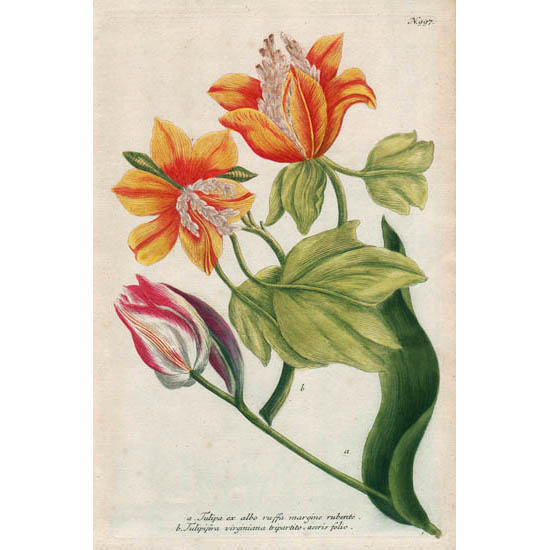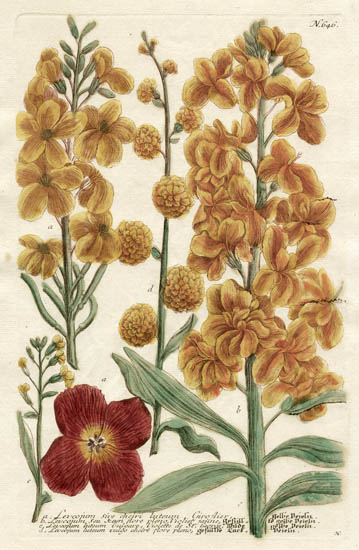Description
Johann Wilhelm Weinmann was an influential apothecary, pharmacist and botanist in Regensburg, Germany. His background is evident in the composition and style of the botanical studies in this work, which are at once scientific or herbal and beautifully decorative as well. He used mezzotint to achieve subtle tonal variations of leaves and flower petals. In Great Flower Books, Satcheverall Sitwell refers to this set as the “pioneering work of botanical prints engraved to be inked in color.”
Many of the superb plates of this important florilegium are engraved after drawings by the eminent botanical artist Georg Dionysus (G.D.) Ehret, the dominant influence in botanical art during the 18th century. Ehret was born in Heidelberg, Germany, and trained as a gardener. He became the protégé of the Margrave of Baden-Durlach, who hired him to design town and palace gardens at Karlsruhe and make paintings of his flowers. After leaving the Margrave’s employ, relocated in Regensburg, where he met Johann Wilhelm Weinmann, and was engaged to produced drawings which were to be his first published works, for Phythanoza Iconographia. Upon producing the first 500 drawings, he had a dispute with Weinmann over compensation and obtained a new position copying plates for another patron, while also working independently on new paintings. His talents were recognized by Dr. Jakob Trew of Nuremberg, who became his lifelong patron and friend. With Trew’s backing, Ehret was able to leave his copying job. He traveled through Europe, including to Leiden in 1736, where he met the eminent naturalist Linnaeus, and then settled in England, where he remained the rest of his life. In London, he had a busy and successful career as a painter and instructor, obtaining numerous commissions from aristocratic patrons and having several duchesses and countesses among his pupils. Over his career, Ehret produced an important body of botanical paintings, including plates for a number of florilegia and travel books, notably Trew’s Plantae Selectae (1750-1773) and Hortus…Amoenissimorum Florum (1750-1786), and his own Plantae Paliliones Rariores (1748-1759) and Natural History of Barbados (1750). He often engraved his own plates. In 1757, he was made a Fellow of the Royal Society. His works today are represented in many important museum collections including the Victoria and Albert Museum and the British Natural History Museum.
Full title of work: Phytanthoza Iconographia, sive conspectus aliquot millium, tam indigenarum quam exoticarum, ex quatuor mundi partibus… plantarum, arborum, fruticum, florum, fructuum, fungorum, &c.
German title: Phythanthoza Iconographia, oder eigentliche Vorstellung etlicher Tausend so wohl einheimisch-als ausländischer aus allen vier Welt-Theilen, in Verlauf vieler Jahr mit unermüdetem Fleisz… Pflanzen, Baüme, Stauden, Kraüter, Blumen, Früchte und Schwämme…
English translation of title: Phythanthoza Iconographia, or comprehensive survey of thousands of native and foreign plants, from all four corners of the world, the result of many years of tireless study… Plants, Trees, Shrubs, Herbs, Flowers, Fruits and Mushrooms…
Condition: Each generally very good with the usual overall light toning, wear, handling. Some variations in overall paper tone. Some with slight irregularities to left margin edge where disbound.
References:
Blunt, Wilfred, rev. by Stearn, William T. The Art of Botanical Illustration. Woodbridge, Suffolk, England: Antique Collectors Club, 1994. pp. 25, 154-55, 159-166, 181.
Dunthorne, Gordon. Flower and Fruit Prints of the 18th and Early 19th Centuries. Their History, Makers and Uses, with a Catalogue Raisonne of the Works in Which They are Found. Washington, D.C.: Published by the Author, 1938. 327.
Brindle, John V., James J. White and Donald E Wendel. Flora Portrayed: Classics of Botanical Art from the Hunt Institute Collection. Pittsburgh, Pennsylvania: Hunt Institute for Botanical Documentation, Carnegie-Mellon University, 1985. p. 494.
Nissen, Claus. Die Botanische Buchillustration: ihre Geschichte und Bibliographie. Stuttgart:1951-66. 2126.
Pritzel, Georg August. Thesaurus Literaturae Botanicae Omnium Gentium. Milan: 1950. 10140.
Sitwell, Satcheverall and Blunt, Wilfred. Great Flower Books: 1700-1900. London: Collins, 1956. pp. 151, 166.






![Weinmann Plate 464 Weinmann Plate 464, Digitalis [Foxgloves]](https://www.georgeglazer.com/wpmain/wp-content/uploads/2017/03/plate464.jpg)










![Homann map, Palaestina [Palestine]](https://www.georgeglazer.com/wpmain/wp-content/uploads/2017/02/homann-palestine-300x300.jpg)


